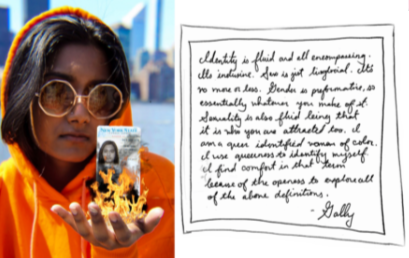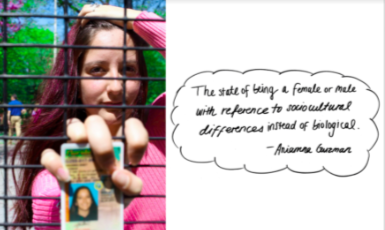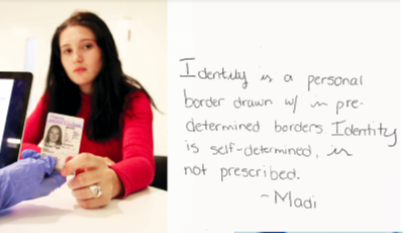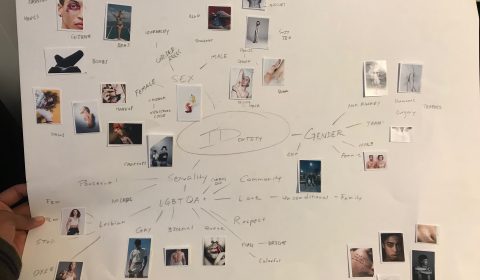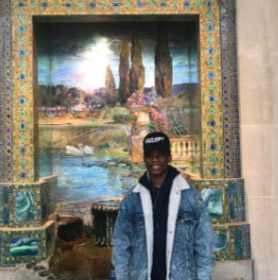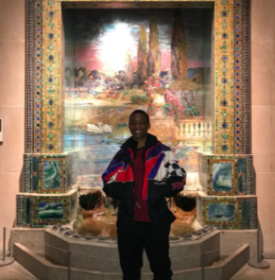My final didn’t come out exactly how I had planned, due mainly to time constraints. However, it was a very fun project to curate and I hope to continue it when I get back to New York and have time. I would also look forward to reshooting the 3 I was able to turn in too, just to make them better and take my time with the process, instead of rushing it. Overall, the process was pretty stressful. The fact that I had to rely on others for my final really pushed me to the edge, however, I really wanted to do this project and it pushed me out my boundaries. There were many time I just wanted to give up or I didn’t think I would have come anywhere near complete, because it wasn’t until the 2nd to last week where people actually started sending in their responses and giving me their availability dates. From there, I only had a week to really put everything together, on top of all my other finals I had to complete. Likewise, something similar took place with my essay. It wasn’t until the 4th week were I actually sat down and got to writing, because The first few weeks I was still figuring out how to narrow my question down from and investigation stance to a valid thesis.
Mind Map:
- final mind map
- 2 iteration
7in7:
Met:
Garden Landscape & fountain by Louis C. Tiffany
- original piece & 100 drawings
- jan 2
- jan 3
City as resource:
Adrian Piper show at the MoMa
Essay:
Identification
Identity and identification are subjective; all bodies and all souls go through this process of creation and recreation in their own way. The harsh parameters of socially accepted performances of sex, gender, and sexuality are used in some instances of identification, while other moments of creation or recreation of identity take place through transcendence of accepted borders into socially unaccepted borders. Using the work of Gloria Anzaldua, Judith Butler, and the words of my peers, I will argue that identification is self-determined in either of those two ways. To say that one must pick a side in what is the “correct” way to identify is to delegitimize many bodies and souls; both processes are legitimate and intimate to the individual.
In Borderlands/La Frontera: The New Mestiza by Gloria Anzaldua, Anzaldua introduces the concept of a third space that exists at borders between nations. She talks a lot about national borders and how a national identity determines how many other identities are read. For instance, a brown body in the United States is racialized differently than a brown body in Mexico. The consequences of being brown are different in these two spaces. All that divides the two is a line imagined and drawn up by humans. A border determines legality and illegality of a body in a space; we call this legality citizenship. Bodies labeled as illegal, undocumented immigrants, are not given human rights because they are not protected by the Constitution. Seen as outside of the law of the nation, these people are also painted as less than human. This new space names the bodies that live in there “illegal.”
A body is seen as legal or illegal in terms of nation borders, but I think we can use borders of land to think about other borders.From Catherine Walsh in Life, Nature, Gender and Otherwise, I gathered that the control and domination of bodies came before the control in ownership and naming of material space. This control of space was made possible by the construction of material borders. How were immaterial borders constructed in this same moment to dominate and separate bodies? Can we think of the social construction of gender as the construction of an immaterial border?
First, we must first ground ourselves in the idea that gender was and is continuously constructed. Using Simone de Beauvoir’s concept of the body as a “historical situation,” Butler believes “that the body suffers a certain cultural construction, not only through conventions that sanction and proscribe how one acts one’s body, the ‘act’ or performance that one’s body is, but also in the tacit conventions that structure the way the body is culturally perceived”.We see here that the construction of the historically situated body is defined by legal actions, or performances, within a space. We can think of accepted gender performances in the same way that we can think of a citizen in a space. Legal performances within borders of gender name a body legal. While, illegal performances within the borders of gender, or performances that transcend gender borders, name a body illegal. We can imagine legal performances of gender as implying a citizen within the citizenship of gender, while illegal performances of gender imply a noncitizen within the citizenship of gender.
We should note that we define a citizen only in relation to the bodied group of citizenship. Likewise, the individual is defined only in relation to the bodied group of gender, women or men. The woman has no way of identifying without the bordered group of women; man has no way of identifying without the bordered group of men. Without borders for definition, the group would not exist. Without the group, the individual ceases to have a reference for self-definition. Immaterial borders require the groups that names bodies legal or illegal and the individual that performs in relation to the group in order to create identification. The group cannot exist without the individual; the individual cannot exist without the group. Women and men cannot exist without woman and man; woman and man cannot exist without women and men.
We can imagine the borders of gender drawn by sex in many people’s imaginations. A woman’s gender is supposedly determined by their anatomy (just a note that this is not how I perceive gender, just how I see many people in the United States understanding gender), lines are drawn based off their anatomy, followed by roles and expectations placed within these borders. An individual is expected to perform legally within this space by maintaining gender norms: physical, emotional, and mental. A body can be determined illegal in two ways when we think of gender in this way. The individual can either act outside of expected gender roles, or they can identify as a gender not associated with their anatomy. Breaking the law of gender places these body outside of the borders, creating a third space. This third space carries consequences that makes an illegal body seem less than human. We can easily think about how being perceived as not quite human leads to oppression.
As stated above, citizenship to bordered material nation space implies a national identity. We can then understand that citizenship to a bordered immaterial gendered space implies a gendered identity. Performances of gender place a body as either within or outside of the gender group giving them a gender identity. Relation to the group in national citizenship and gender citizenship define the individual and border their identity. How though, can we think about the individuals that define themselves outside of accepted borders of identity?
Broadly understood by most in society as “others” or “outcasts,” I believe that we should reframe our understanding of the individual that defines themself through transcendence of borders. Take for instance my own journey through gender identification as a transman. Before crossing the borders of prescribed gender I had been given as birth, I was unable to truly relate myself to the world. After transcending gender borders, I have a way of identification, a way of seeing and knowing myself, and relating that self to others. Entering this third space of existence, like the one that Gloria Anzaldua writes to, I found a new appreciation for myself and for the women around me. Transcendence of borders allowed me to discover what exactly how I define the borders of womanhood and manhood; I was not fully attuned to the rules and parameters of gender until I transcended them. For this reason, entering this third space has beautiful consequences.
I spent 18 years held to the borders of gender that had been prescribed to me; while this prescription works in favor for some, it did not for me. I did not identify within the parameters of gender I was supposed to be living through; transcendence of these borders allowed me to find myself, to feel comfortable in my own skin. Not only did this movement into a third space allow me to identify with who and what I truly am, a man, but it also gave me the space to learn more about sex, gender, and sexuality then had been previously provided to me by the rigid parameters I had been taught to live through. Most importantly, I learned that transcendence is not about what will make the people around you happy, in fact, many people have been not so happy with my act of transcendence. Rather, it is about finding comfort in your own self, about feeling at home, about being truly happy with who you are.
For some, adherence to their given borders of gender works. For instance, I asked several people in my life to define what identity, sex, gender, and sexuality meant to them. While some of my cis-gendered friends defined gender in ways that spoke only to their own experience, that did not transcend the borders of gender, others of them spoke in ways that seemed to mirror my own understanding of gender. This is to say that you don’t have to identify outside of the female/male binary to understand your gender through transcendence. Every individual learns to navigate their bodies, their souls, their actions in their own way. To deem one way of identification as superior to the other is to implement a hierarchy of bodies, of which we have seen through capitalism as dangerous, is wrong. We should rather provide the space for all kinds of identification, adherence to or transcendence of borders are both valuable and intimate ways of understanding one’s self.
Bibliography
Anzaldúa, Gloria. Border Arte: Nepantla, el lugar de la frontera and Geographies of Selves –Reimagining Identities in Light in the Dark/Luz en lo oscuro. (Durham: Duke University Press, 2015) 69
Butler, Judith. Performative Acts & Gender Constitution. (John Hopkins: University Press, Maryland, 1988) 523-524
Kierkegaard, Soren. The Present Age: On the Death of Rebellion HarperCollins Publishers — World Leading Book Publisher, www.harpercollins.com/books/Present-Age-Soren-Kierkegaard/?isbn=9780061990038.
Walsh, Catherine. Life, Nature, Gender and Otherwise: Feminist Reflections and Provocations from the Andes In Wendy Harcourt and Ingrid Nelson (ed.) Practicing Feminist Political Ecologies: Moving Beyond the Green Economy. (London: Zed Books, 2015) 104
Zolberg, Aristide R. A Nation by Design: Immigration Policy in the Fashioning of America. Russell Sage Foundation, 2008.

